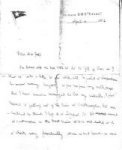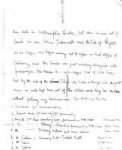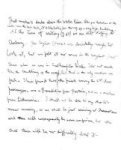Fr Thomas Roussel Davids Byles 1 was born at Grosvenor-road, Headingley, England on 26 February 1870, to Louisa Davids and Alfred Holden Byles; he was the eldest of seven children.
Byles' father, the Reverend Dr. Alfred Holden Byles was a congregational Minister and a successful businessman. He was the first pastor of Headingley Hill Congregational Church, Leeds. Records show the family's home address as York Road Council Schools, Leeds, Yorkshire. In the 1890s he was the Minister of Shelton-Hanley, Stoke-on-Trent and also lived for a time in Omaha, NE, USA with his wife and two of their children (a daughter and Winter, their son). Whilst in America he supplied the First Congregational Church in Omaha with a pulpit. The family later returned to England. Rev Byles senior died on 8 December 1911 2.
Byles' uncle, Mr F. Byles, lived in Bradford, and another uncle—who was born in Bradford—was Sir William Pollard Byles (1839?1917), radical, social reformer and member of Parliament for Salford North (elected 1906). One of Roussel's sisters became a missionary in China.
Byles was educated at Leamington College and Rossall School, Fleetwood, Lancashire (1885?89) where he was a 'scholar' and school monitor for Crescent House.
In 1889 Byles went to Balliol College, Oxford 3 where he studied mathematics, modern history and theology. He was also Vice-President of the Arnold Society (a select undergraduate debating society at Balliol). He graduated as a Bachelor of Arts (BA) in 1894. While studying at Oxford he converted to Catholicism and the following year went to work as a Master at St Edmund's College, Ware, Hertfordshire, a boys' school and Roman Catholic seminary. In 1897 he wrote 'A School Commentary on 2nd Epistle of St Paul to the Corinthians', his only published work.
Byles it would appear was not in generally good health his letters allude to occasional beak-downs and fits:
I hope to enter some Religious Order early in next year, but I want to wait a little, partly because I have not yet found out which Order I am best fitted for, & partly because my doctor tells me that by next February, if I have not recurrence, I may consider myself quite cured of my fits, & till that is safe it would probably be difficult to find any Order willing to accept me.
Sept 14, 1897
Byles worked at St Edmund's until 1899 when he travelled to Rome to study for the priesthood. He received a B. D. (Bachelor of Divinity) from Gregorian University in 1901 and was ordained on 15 June 1902; he finished his studies in Rome in 1903. From 1905 to 1912 he was the Roman Catholic Rector of Ongar, Essex.
Byles' younger brother William also converted to Catholicism but moved to America to run a rubber business and fell in love with Katherine Russell of Brooklyn. When they planned to marry William asked his brother to officiate at the ceremony (planned for the Sunday after his arrival). He and his brother Winter (living in America) made arrangements to travel to New York. Fr Byles was initially scheduled to travel on another White Star liner but switched at the last minute to the Titanic. His second class ticket was number 244310 and cost £13. He boarded the Titanic at Southampton on 10 April 1912.
While the Titanic lay at anchor at Cherbourg he wrote to his housekeeper, Miss Field back at his parish in Chipping Ongar, Essex
In the letter, which left the ship at Queenstown the following day, he gives a description of the ship and the journey from Southampton to Cherbourg. He found the vibration of the ship unpleasant but said that although the sea appeared rough there was no reflection of this on the ship itself. He also mentioned meeting two other priests in second class 5 one a Benedictine from Bavaria, and one is a secular from Lithuania6.
On the morning of Sunday 14 April Father Byles held the Catholic mass with second class passengers in their lounge and afterwards with the third class passengers for whom Fr Byles delivered a sermon in English and French, Fr Peruschitz followed with a sermon in German and Hungarian. According to an article in The Evening World the two priests preached on the need to have a "lifeboat in the shape of religious consolation at hand in case of spiritual shipwreck".
After the collision—by many accounts—Father Byles was a hero till the end, helping the third class passengers up the stairs, into the boats, hearing confessions and praying with those that had been unable to escape. Some newspapers reported that he was offered a seat but had refused.
'Continuing the prayers, he led us to where the boats were being lowered. Helping the women and children in he whispered to them words of comfort and encouragement.'
The Evening World, April 22 1912 Miss Bertha Moran
Father Byles died in the sinking. His body, if recovered, was never identified.


Memorial Card for Fr. Byles
(© Encyclopedia Titanica / Courtesy Joan Barry, USA)
Katherine and William did not reschedule their wedding. They had another priest perform the ceremony. In a Brooklyn newspaper it reported the bride and groom went home from the wedding and changed into mourning clothes and returned to the church for a memorial mass. The couple then left for a short honeymoon in New Jersey.
Later that year Katherine and William travelled to Europe. They visited London and the Houses of Parliament to meet 'Uncle Willie' (Sir W. P. Byles). Katherine had to wait outside in a parlour—women could not enter. According to family legend, a young man came to her and said "Hello Mrs Byles, I am here to give you a tour, my name is Winston Churchill". From London they travelled on to Rome where they had a private audience with the Pope, who declared Father Byles a martyr for the Church.
A door installed by his brothers at the Roman Catholic Church in Chipping Ongar, Essex, stands as a memorial to Father Byles. A memorial photograph of him also hangs there.






Comment and discuss
-
Your site is very good, My Great uncle was Father Thomas Roussel Byles of the second class. I have a letter from him posted in Queenstown.I can scan and send if you are interested. He is mentioned in many books as praying and hearing confessions till the end. He was on his way to officiate the wedding ceremony of my Grandparents. One newspaper reports he was offered a seat three time and each time he refused it to stay with the doomed passengers. The pope declared him a martyr. Joan Byles Barry Grand niece of Father Byles 2nd class New Jersey
-
Thank you very much for the great page! I have been looking for information on Fr. Byles, and was happy to find so much on your site. I have long been a Titanic buff, and have always been inspired by the bravery of Fr. Byles (and the two other Catholic priests) during the sinking. Keep up the great work. Fr. Archer Illinois
-
I am a relative of Rev. Thomas Rousel David Byles. Looking for other members of the Byles Family...Would love to get in touch with anyone who has any additional information about Rev. Byles or the Byles Family. Lora Byles Texas
-
So glad to finally find some info on Rev. Byles, whome I have confirmed as a relation to my grandfather, James A.Byles,on whome I have a family tree, and he is a direct decendant of Sir William Pollard Byles. who origionaly was decendant of a Byles from Connamora, Ireland, and was given a land grant in England, and the name was origionally Boyle, and because of a mistake on a manifest, rather than go to the trouble of changing it , it was left as byles. My great Uncle Leslie Byles O.B.E. deceased, was my Mother's second cousin, Leslie has a son Allan, and a daughter Shirley living in London, whome I am going to visit in July. Thankyou so much for this information, when in England I am going to check out some more info on him. Beryl Welburn Nova Scotia, Canada
-
I have a great interest in Father Thomas Byles, who was a passenger on the Titanic and who gave such help to many passengers. He was my predecessor in this parish in 1904 Arthur Barrow Kelvedon Essex England
-
On Father Byles' biog page there is a letter from William Byles to his mother-in-law, which includes the passage: 'From St Vincent's we went to the Chelsea Hotel, where we met Mr & Mrs Bean, who had only been married a month, and were both saved together. They knew little, but they gave us the address of Roussel's cabin companion. If he has been saved we may hear more from him.' This is a long shot, but does anybody know the identity of Father Byles' cabin companion, or what onboard connection existed between this person and Ted and Ethel Beane (or perhaps between father Byles and the Beanes)?
-
hello everyone i have some new information concerning fr byles i have just read an article that said fr graham smith the current parish priest of saint helens church the church where byles was priest at has launched an effort to make fr byles a saint i will post a copy of that article here . may he one day become a saint.
-
Hi Joan, my great Grandmother was Rosa Russel, sister of Katherine Russel who must have been your Grandmother, please send me pictures if you have them
-
Sean, please note that Joan's message is from 1997 and that she's no longer a registered Message Board user. It would seem unlikely that she'll respond to you.
-
Hi Sean Sister Joe McCarthy used to visit us in NJ every summer, I went to Kitty’s wedding with my mother in late 60,s and met the family, I do have pictures that I can share
-
Rev. Byles' sister, Dr. Hilda Margaret Byles, was a colleague of my granduncle, Dr. George Hadden. He was at her funeral in July 1931, in Hankow, China. You may find me on Facebook. My name: YVONNE FREUNDL (HADDEN)
-
I was wondering if Thomas Byles, as a priest, would be wearing the cassock most of the voyage. My friend said he would only wear it during Mass and then only wear a suit, but I'm not sure. Did he wear it most of the time?
Open Thread Leave a Reply